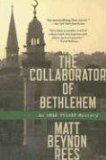Summary | Excerpt | Reviews | Beyond the Book | Read-Alikes | Genres & Themes | Author Bio

Critics' Opinion:
Readers' Opinion:
First Published:
Feb 2007, 272 pages
Paperback:
Jan 2008, 272 pages
 Book Reviewed by:
Book Reviewed by:
BookBrowse Review Team
Buy This Book
This article relates to The Collaborator of Bethlehem
The Canaanites are the earliest known civilization to live in the area of land at the eastern end of the Mediterranean Sea, living in city-states such as Jericho around 3,000 BCE. Positioned close to Egypt, Syria, Mesopotamia and Asia Minor the area was not only a meeting point for different cultures but also a battleground for various empires such as the Assyrians and Egyptians, and was fought over by different groups of invaders including the Amorites, Hittites and Hurrians.
Around the 14th century BCE, Egyptian power in the region weakened and new groups, the Hebrews and the Philistines, appeared. Around 1050 BCE the Philistines defeated the Israelites. About 50 years later, Israel's King David defeated the Philistines and established a large independent state with its capital at Jerusalem. Less than a hundred years later, due to internal power struggles, the kingdom was divided into Israel in the north and Judah in the south.
Circa 720 BCE the northern kingdom of Israel was defeated by the Assyrians, and a little over 100 years later Judah was conquered by the Babylonian empire, destroying Jerusalem and the Temple, and enslaving most of the Jewish population. However, in 539 BCE, the Persian Empire conquered Babylonia and they allowed the Jews to return to Judea, now under Persian rule.
In 333 BCE, Persian domination of the region was replaced by Greek rule; about two centuries later, around 130 BCE, the Jews revolted and set up an independent state, but were put down. In 63 BCE Jerusalem came under Roman control.
In the 4th century AD, the Roman emperor Constantine legalized Christianity and most of the population of the area became Christians. In the 7th century, Muslim Arab armies invaded the region and captured Jerusalem beginning 1300 years of almost continuous Muslim rule over the area known as Filastin.
In 1099, Jerusalem was captured by the Crusaders but was taken back by Saladin about 90 years later.
From the 16th century to the end of World War I the Ottoman empire ruled the area, placing administration largely in the hands of Arab Palestinians, but allowing the Christian and Jewish communities a large measure of autonomy. But at the outbreak of World War I, Britain promised the independence of Arab lands under Ottoman rule, including Palestine, in return for Arab support against Turkey. In 1917 the British government issued the Balfour Declaration promising the establishment of a national home for the Jewish people.
Despite Palestinian objections, Jews began to migrate to Palestine in large numbers from 1918 (the area was under British administration until 1948 as a result of the Mandates System adopted by the League of Nations). Protests and bloodshed continued and in 1936 the Palestinians held a six-month General Strike to protest against the confiscation of land and Jewish immigration. In 1947, Britain pulled out of Palestine, leaving it in the hands of the United Nations, which went ahead with the partition that had been proposed by the British - two independent states with Jerusalem internationalized as a neutral "sacred-site". However, following partition, Arab Countries refused to accept this partition and launched a war against the new Jewish state after which Israel ended up occupying 77% of the territory and the larger part of Jerusalem. Over half the indigenous Palestinian population fled or were expelled. Jordan and Egypt occupied the other parts of the territory that had been assigned by the partition resolution to the Palestinian Arab State, which did not come into being.
In the 1967 war, Israel occupied the remaining Palestinian territory (the West Bank and Gaza Strip including the remaining parts of Jerusalem) and a further 1/2 million Palestinians were displaced. Despite a Security Council resolution calling on Israel to withdraw from the occupied territories; Palestinians in the West Bank, including east Jerusalem, have lived under Israeli occupation since 1967. The settlements that Israel built in the West Bank are home to around 400,000 people and are deemed to be illegal under international law, although Israel disputes this.
In 2005, Israel evacuated all of its settlers (about 8,000) from the Gaza Strip, and withdrew its forces. However, Israel controls maritime, airspace, and most access to the Gaza Strip.
In January 2006, the Islamic Resistance Movement, HAMAS, won control of the Palestinian Legislative Council (PLC). The international community has refused to accept the HAMAS-led government because it does not recognize Israel, will not renounce violence, and refuses to honor previous peace agreements between Israel and the Palestinian Authority.
Filed under Places, Cultures & Identities
![]() This "beyond the book article" relates to The Collaborator of Bethlehem. It originally ran in April 2007 and has been updated for the
January 2008 paperback edition.
Go to magazine.
This "beyond the book article" relates to The Collaborator of Bethlehem. It originally ran in April 2007 and has been updated for the
January 2008 paperback edition.
Go to magazine.





The Flower Sisters
by Michelle Collins Anderson
From the new Fannie Flagg of the Ozarks, a richly-woven story of family, forgiveness, and reinvention.

The House on Biscayne Bay
by Chanel Cleeton
As death stalks a gothic mansion in Miami, the lives of two women intertwine as the past and present collide.

The Funeral Cryer by Wenyan Lu
Debut novelist Wenyan Lu brings us this witty yet profound story about one woman's midlife reawakening in contemporary rural China.
Your guide toexceptional books
BookBrowse seeks out and recommends the best in contemporary fiction and nonfiction—books that not only engage and entertain but also deepen our understanding of ourselves and the world around us.